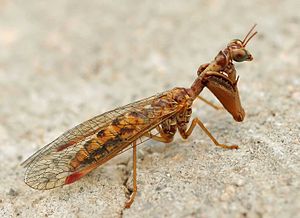Styrian catchment
| Styrian catchment | ||||||||||||
|---|---|---|---|---|---|---|---|---|---|---|---|---|

Styrian Fanghaft ( Mantispa styriaca ) |
||||||||||||
| Systematics | ||||||||||||
|
||||||||||||
| Scientific name | ||||||||||||
| Mantispa styriaca | ||||||||||||
| ( Poda , 1761) |
The Styrian Fanghaft ( Mantispa styriaca ) is a reticulated wing from the family of the Fanghaft (Mantispidae). Together with the closely related confused Fanghaft ( Mantispa aphavexelte ) it is one of the two species of the family found in Central Europe .
features

The Styrian Fanghaft reaches a body length of 15 to 35 millimeters. His physique comparable to other mantispidae which he also removed the unspecified related mantis recalls. But it is much smaller than most representatives of this order. Similarities are the greatly elongated thorax , the triangular head and the arrangement of the legs including the thorny first pair of legs, which have been transformed into tentacles. The large and well-developed eyes are also located on the two upper corners of the head, but like other reticulated wings they have a metallic sheen. In a resting position, the tentacles are not positioned under the thorax, but behind it, unlike in terrors. Another difference is the length of the antennae, which is significantly longer in the terrors. The structure of the wings is largely identical to that of other net wing aircraft. The basic color of the Styrian Fanghaftes is brown.
Occurrence
The Styrian Fanghaft lives particularly in the Mediterranean region. To the north, the distribution area probably ends in Austria, where the species u. A. lives in Styria, which also earned it its German name. Further occurrences in climatically favorable zones are assumed. The Styrian Fanghaft is a warmth-loving species and inhabits the vegetation, including bushes, in such habitats.
Way of life
The Styrian Fanghaft is active both day and night. It usually hangs on the underside of leaves. With the thorny fang legs, as in the case of fishing fright, prey is captured at lightning speed.
Reproduction
The Styrian Fanghaft can be found from June to August. Some time after mating, the female lays eggs sitting on stalks on tree bark, the number of which can be up to 8,000. The hatched larva does not eat any food at first. It overwinters and sheds its skin in spring. Subsequently, the parasitoid development typical of the captive begins , in the case of the Styrian captive with wolf spiders . The larva tries to penetrate the egg cocoon of a wolf spider, which is made more difficult by the fact that wolf spiders care for their brood and defend their cocoon. Presumably this is why the number of clutches in captivity is so high. The larva feeds on the hatched spiders and, like the larvae of other captives, changes its shape over time to a short-legged and maggot-like appearance. The larva pupates in the spring in the cocoon carried by the spider and leaves it after about four weeks as a nymph before it sheds its skin for adult capture.
Systematics and nomenclature
First describer Nikolaus Poda von Neuhaus published his work Insecta Musei Graecensis in Graz in 1761 . It is the first purely entomological work that completely followed the nomenclature of Carl von Linné , just three years after the publication of the 10th edition of Linné's fundamental work Systema naturae . In Poda's book, the Styrian catching detention was also described under the species name Raphidia styriaca . In 1775, Johann Christian Fabricius described the species Mantispa pagana in his work Systema Entomologia , which can be easily identified as Raphidia styriaca, previously described by Podas . The term mantispa pagana established itself very quickly and is sometimes still used as a synonym today. The name Mantispa styriaca used today was finally taken up by Herbert Hölzel , based on the name Podas.
gallery
Styrian Fanghaft cleaning himself on a caper leaf
Individual evidence
- ↑ a b c d e Heiko Bellmann: The KOSMOS Insect Guide Kosmos Naturführer, Kosmos (Franckh-Kosmos), 1st edition, 2018, p. 130, ISBN 978-3-440-15528-8 .
- ↑ a b c Erich Kreissl: On the occurrence of the reticulated winged Mantispa styriaca (Poda) in Styria. In: Communications from the Department of Zoology and Botany at the State Museum “Joanneum” in Graz , Volume 19, 1964, pp. 11–16, ( Link ).



